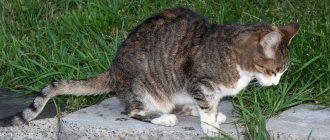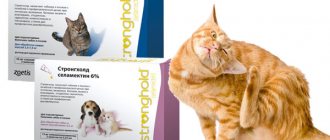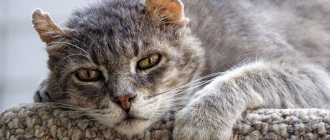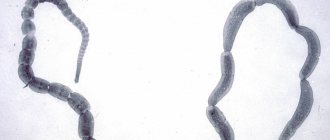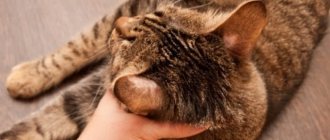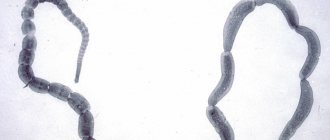Recommended Medicines
- Fact 1:
The disease has many names, but none of them change the essence - it is a deadly infection - Fact 2:
The older the animal, the more successfully it fights the disease, and the symptoms of distemper are weaker. - Fact 3:
Vitafel. Immunoglobulin serum. Affects the causative agent of plague - Fact 4:
Fosprenil. Injection solution based on pine needle extract
For every pet owner, his illness is a disaster. But the plague is a doubly tragedy. You can never predict how it will turn out for a small patient, because the danger of the disease is difficult to compare with any other infections. And the outcome can be the saddest, even with good medical care.
And all because a person can only alleviate the suffering of an animal, reduce pain, and support the affected organs. But the animal will have to fight the dangerous disease on its own. And it depends only on the strength of the body whether the pet will be able to overcome the infection or will go out like a candle, sometimes literally within a day.
The relationship between the pathogen and the age of the pet
Distemper, also known as panleukopenia, also known as viral enteritis, parvoviral gastroenteritis. The disease has many names, but none of them change the essence - this is a deadly infection that does not spare cats at any age. And yet, each age group has its own degree of threat.
Newborn kittens that were infected in the womb are at greatest risk. The survival rate for this category of patients is only 10%. Moreover, plague most often progresses rapidly. The following signs appear first:
- In children, immobilization occurs;
- kittens stop nursing;
- The animals squeak pitifully, waiting for help.
Despite all the measures taken, the symptoms of the disease persist and young patients, unfortunately, soon die.
Survival rates for adults are slightly better. Moreover, the older the animal, the more successfully it fights the disease, and the weaker its signs of panlecopenia.
Such cats have a 30-60% chance of recovery.
Older animals no longer have the same strength of body and immune system as animals in their prime, so the mortality rate from distemper among them is as high as among small kittens.
Effect of ethanol
There is a myth that ethanol is a natural metabolite. It is not true. There is not a single reaction that occurs inside a living organism that would result in the production of ethanol. At the same time, there are many bacteria in the intestines whose task is to produce vitamins, process fiber, and some of them produce ethanol (about 3 grams per day). However, there are no such microbes inside the cat’s intestines; they exist only in the gastrointestinal tract of humans and other omnivores and herbivores.
Ethanol is a neurotoxic poison, a carcinogen and a drug that suppresses the activity of the central nervous system. Suppression of the nervous system is possible up to coma and death. The lethal dose is 5-8 ml of alcohol per kilogram of weight, that is, for a cat this is about 3-4 tablespoons of 40% vodka (it contains 20 ml) or teaspoons of pure ethanol.
Stages of intoxication with increasing dose
When consuming small doses, the “reward system” is activated, the active substance of which is dopamine. The purpose of these reactions is to motivate the animal to perform certain actions: sex, successful hunting, victory over an opponent in a territorial fight. However, you should not think that you can give your cat alcohol to “relax” it, since the “useful” dose is too small - literally 0.1 ml of ethanol or 0.3 ml of vodka. It is inconvenient to administer such an amount of alcohol even through a syringe.
A further increase in the dose depresses the activity of the central nervous system; every person has seen all these aspects more than once or even experienced it on himself:
- the brain’s ability to concentrate on various thoughts decreases, only one idea remains (usually not a good one);
- coordination of movements is impaired;
- the hunger center is stimulated, that is, the animal’s appetite increases;
- the last stage is narcotic dreamless sleep.
Sobering up
It begins simultaneously with intoxication, but since this process is slow, its result is felt only after stopping drinking alcohol.
Sobering up is directly related to the destruction of ethanol.
It goes in 2 stages:
- Decomposition of ethanol to acetaldehyde . Several systems in the body are responsible for this; the transformation of alcohol occurs both inside cells and in the blood, liver and intercellular fluid.
- Decomposition to acetic acid . This stage of decomposition takes place exclusively inside the cells, which is why the speed of this stage is greatly inhibited.
It is acetaldehyde that is the main cause of all the unpleasant sensations of a hangover. Moreover, the second stage takes much longer than the first. As a result, due to the difference in speed, acetaldehyde accumulates, which is not destroyed immediately, resulting in a hangover.
Treatment methods
You can start treatment only when there is no doubt about the correctness of the diagnosis. And this does not depend on the dubious knowledge of the owner, who determines the disease “by eye,” but on a medical examination, clinical picture and laboratory blood test. Medical therapy involves complex treatment aimed at eliminating the symptoms of infection.
However, there are also so-called “traditional healers” who offer a very dubious method - drinking the animal with vodka. Let's consider both options.
Symptoms and signs of distemper in cats
Of course, the symptoms and signs of the disease largely depend on both the condition of the animal at the time of the disease and the form of the disease.
How does the disease manifest itself?
But how does plague manifest itself in common, “classical” cases? In hyperacute cases, the following symptoms are characteristic:
- Kittens (as we have already said, this form is typical for them) suddenly and for no apparent reason stop sucking.
- Pets constantly squeak, worry, and quickly weaken.
In many cases, death occurs within three to five hours from the onset of clinical signs. But! Many veterinarians talk about the existence of a fulminant form of the disease. In such cases, there may be no symptoms at all. Kittens simply die due to massive damage to the nervous system. This happens very quickly, and therefore the owners, as a rule, do not have time to do anything.
In acute cases, breeders usually have time to suspect something is wrong, and usually even call a veterinarian in time if the following signs appear:
- Animals are depressed and refuse to eat and, in the most severe cases, even drink. Alas, the last sign quite “transparently” indicates a very high probability of death.
- Vomiting appears.
- A characteristic sign of an acute course is also considered to be an increase in the animal’s general body temperature to 40-41° Celsius.
- After about three days, diarrhea begins. At first, the stool is simply liquid, but quickly acquires a mucous consistency and a greenish tint. When things get really bad, copious amounts of blood and clots of fibrin (blood protein, in the form of whitish-gray threads) appear in the feces.
- The cat's abdomen is noticeably swollen; when it is palpated, the pet meows loudly, hisses and tries to escape (i.e., severe pain appears).
Intestinal form of the disease
Sometimes pure intestinal distemper occurs. In such cases, damage develops (as you might guess) to the organs of the digestive system. In this case, the disease is characterized by vomiting, diarrhea with copious amounts of blood, bile and mucus, as well as exhaustion and dehydration. Sick cats often sit in front of a full bowl of water but do not drink. This is associated with severe abdominal pain. Since the intestines in this form are swollen with gases, the animal reacts very nervously to attempts to feel the abdominal cavity.
Nervous form of the disease
In general, nervous distemper is a rather vague concept. The problem is that any form of panleukopenia in this case implies damage to the central nervous system (CNS). Thus, only the hyperacute course of the disease, when death occurs precisely as a result of damage to the central nervous system, should be recognized as exclusively nervous.
Pneumonic plague
The pulmonary form of the disease is rare. As is easy to understand, it is characterized by damage to the respiratory system (cough, hoarse and strained breathing). Note that the panleukopenia virus itself does not cause such an outcome. The problem is the proliferation of secondary pathogenic microflora.
Cutaneous form of the disease
Veterinarians have been arguing for a long time about whether cutaneous distemper exists at all. Most likely, there is no such form of the disease, and skin lesions during plague are caused exclusively by the development of secondary pathogenic microflora (it is much easier for it to “take root” in an organism already weakened by the disease).
Mixed plague
Thus, the mixed form is the most typical and common case. Characterized by a combination of all of the above characteristics.
Antiviral complex
Vitafel . Immunoglobulin serum. It affects the causative agent of panleukopenia in animals at any age, incl. during pregnancy and lactation. There are no contraindications or side effects. The product can be combined with any other medications. The drug is administered subcutaneously, twice per course (once a day) at the rate of 1 ml for a pet weighing up to 10 kg, 2 ml for an animal over 10 kg.
Fosprenil . Injection solution based on pine needle extract. It is used simultaneously with other symptomatic remedies, which gives the best effect. Placed subcutaneously, dose calculation: 0.5 ml per 5 kg of weight, if the pet weighs less than 1 kg - 0.2 ml. Scheme:
- 1-2 days – 2 times;
- from 3 to 10 days – 3 times;
- from 11 to 13 days – 2 times;
- 14-15 days – 1 time.
Enterostat . 1 injection once weekly. For every kg of weight – 20 mg of the drug.
In addition, other therapeutic measures are carried out in parallel:
- hyperimmune serum - in the first few days of the disease;
- vitamin complex to strengthen the immune system;
- glucose intravenously or subcutaneously (5% solution) to maintain the body;
- corticosteroid drugs to relieve shock;
- salt solutions drip to relieve intoxication;
- antiemetic to prevent dehydration.
If there is a concomitant infection, then antibacterial drugs are used.
Consequences after the disease
Successful recovery does not guarantee that the animal will not have health problems in the future. After an illness, there is a high probability of developing chronic inflammation of internal organs and systems. However, it’s up to the cat’s owner to do everything, because it’s possible to prevent the problem with three simple steps:
- Timely vaccination;
- Preventive examination at a veterinary clinic, especially if any symptoms are observed;
- Careful care for your pet: good nutrition and comfortable living conditions.
Use of vodka
Every animal owner knows a lot of information about how dangerous distemper is. And that this disease gives very little chance of survival to a small patient. Anyone who has familiarized themselves with the extensive list of drug therapy understands that the fight against pathology requires the use of a considerable number of drugs.
And, nevertheless, there are still such wise men who naively believe (and advise everyone to verify in practice) that ethanol vapors can cure parvovirus gastroenteritis. And all just because someone, somewhere, once heard that vodka mixed with a raw egg is a panacea for such a terrible disease. How strong is the denseness of some people who are ready to experiment on the life of their own pet. No and no again. Neither vodka nor eggs have any effect on the feline distemper virus. But the poisonous vapors of alcohol are quite capable of ruining the already weak body of a sick animal.
Summarize
Although the nature of the article is somewhat sarcastic and partly cynical, in fact this is the author’s defensive reaction to all the monstrous nonsense that people do to themselves and their pets.
I repeat that this is the 21st century, people have learned methods of artificial insemination, are transplanting organs, creating bionic limbs, Mars is being colonized, in the end, and there is absolutely no reason to turn to “old-fashioned” methods and all sorts of charlatan theories. Veterinary medicine is a high-tech and highly scientific field that is constantly developing and has stepped far forward since the days of rural farriers and scarce garlic-vodka treatment!
Be wise and merciful, because you are responsible for the life and health of your pet.
KotoDigest Thank you for subscribing, check your inbox: you should receive an email asking you to confirm your subscription
Prevention
Plague is a disease with which you should not tempt fate. Veterinarians never tire of repeating: animals must be vaccinated! This procedure is very successful in protecting cats from this terrible disease.
The effects of the vaccine should theoretically last for 3 years, but doctors advise not to skimp on your health and to get vaccinated annually after a two-stage vaccination:
- 1 – at the age of 8 weeks.
- 2 – at the age of 12 weeks.
Do not forget that the causative agent of the virus is extremely tenacious; it can be carried on street shoes, objects, and belongings. Be especially attentive to animals taken from places where animals gather: markets, nurseries.
Help with frostbite
In winter, cases of frostbite in furry pets are common. Most often, the tail, limbs, ears or nose are affected. The main signs of frostbite are pale skin in the area of the lesions and the appearance of dense swelling. In severe cases, the skin of the mustachioed tabby becomes covered with blisters or swelling.
Treatment with vodka. In case of significant frostbite, “fire water” comes to the aid of a loving owner. Saving a cat from exposure to low temperatures must occur in strict order:
- First, the affected areas should be washed with soap and water. The liquid should not be too cold or hot. You need to start with a temperature of +18-20°C, gradually bringing it to 40°C.
- Then the animal needs to be rubbed with vodka, gently massaging the frostbitten areas.
- After restoring blood flow to the cat, give the cat another rub.
It is important to remember that if it is not possible to bring a frostbitten pet indoors, you should place it under clothing and warm it with your own heat.
Rubbing with snow is contraindicated for animals.
Also watch the video: Is it worth treating dogs and cats with vodka:
